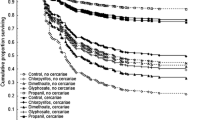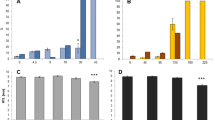Abstract
Three frog species (Limnodynastes tasmaniensis, Limnodynastes fletcheri and Litoria raniformis) were surveyed in rice bays of the Coleambally Irrigation Area (CIA), NSW, Australia, during the rice-growing seasons of 2005/2006 and 2006/2007. A total external morphological abnormality index of 7.0% was observed in frogs of the CIA (n = 1,209). The types and frequencies of abnormalities were typical of reports from agricultural areas with ectrodactyly being the most common aberration. A relatively low abnormality index of 1.2% was observed in L. raniformis (n = 87) compared to indices of 7.1% and 8.2% observed in L. fletcheri (n = 694) and L. tasmaniensis (n = 428), respectively. No conclusive evidence was found of unnaturally high rates of intersex, gonadal maldevelopment or unbalanced sex ratios in any species. Rice bay surface waters differed significantly in mean pesticide concentrations of atrazine and metolachlor on farms growing rice and corn compared to farms with rice as the sole crop. However, the similar abnormality indices observed in recent metamorphs emerging from these two farm types provided no evidence to suggest a link between larval exposure to the measured pesticides and developmental malformations.
Similar content being viewed by others
References
Ankley, G. T., Tietge, J. E., DeFoe, D. L., Jensen, K. M., & Holcombe, G. W. (1998). Effects of ultraviolet light and methoprene on survival and development of Rana pipiens. Environmental Toxicology and Chemistry, 17(12), 2530–2542.
Anstis, M. (2002). Tadpoles of south-eastern Australia, a guide with keys. Frenchs Forest: World Wide Fund for Nature Australia, World Wildlife Fund Australia, New Holland.
ANZECC & ARMCANZ (2000). Australian and New Zealand guidelines for fresh and marine water quality. Volume 1: The guidelines. Resource document, Australian and New Zealand Environment and Conservation Council, Agriculture and Resource Management Council of Australia and New Zealand. http://www.mincos.gov.au/publications/australian_and_new_zealand_guidelines_for_fresh_and_marine_water_quality . Accessed 22 April 2006.
Blaustein, A. R., & Johnson, P. T. J. (2003). The complexity of deformed amphibian. Frontiers in Ecology and the Environment, 1, 87–94.
Bonin, J., Ouellet, M., Rodrigue, J., & DesGranges, J. L. (1997). Measuring the health of frogs in agricultural habitats subjected to pesticides. In D. M. Green (Ed.), Amphibians in decline: Canadian studies of a global problem (pp. 246–257). Saint Louis: Society for the Study of Amphibians and Reptiles.
Britson, C. A., & Thelkeld, S. T. (1998). Abundance, metamorphosis, development and behavioural abnormalities in Hyla chrysoscelis tadpoles following exposure to three agrichemicals and Methyl Mercury in outdoor mesocosms. Bulletin of Environmental Contamination and Toxicology, 61, 154–161.
Burkhart, J. G., Ankley, G., Bell, H., Carpenter, H., Fort, D., Gardiner, D., et al. (2000). Strategies for assessing the implications of malformed frogs for environmental health. Environmental Health Perspectives, 108(1), 83–90.
Clampett, W. S., & Stevens, M. M. (2002). Rice notes: A supplement to production of quality rice in south eastern Australia, rice crop protection guide 2002 (p. 8). NSW Agriculture and the Rice Research and Development Committee.
Coady, K. K., Murphy, M. B., Villeneuve, D. L., Hecker, M., Jones, P. D., Carr, J. A., et al. (2005). Effects of atrazine on metamorphosis, growth, laryngeal and gonadal development, aromatase activity, and sex steroid concentrations in Xenopus laevis. Ecotoxicology and Environmental Safety, 62(2), 160–173.
Cooke, A. S. (1981). Tadpoles as indicators of harmful levels of pollution in the field. Environmental Pollution (Series A), 25, 123–133.
Du Preez, L. H., Solomon, K. R., Carr, J. A., Giesy, J. P., Gross, T. S., Kendall, R. J., et al. (2005). Population structure of the African clawed frog (Xenopus laevis) in maize-growing areas with atrazine application versus non-maize growing areas in South Africa. African Journal of Herpetology, 54(1), 61–68.
Eaton, B. R., Eaves, S., Stevens, C., Puchniak, A., & Paszkowski, C. A. (2004). Deformity levels in wild populations of the wood frog (Rana sylvatica) in three ecoregions of Western Canada. Journal of Herpetology, 38(2), 283–287.
Garber, E. A., Erb, J. L., Magner, J., & Larsen, G. (2004). Low levels of sodium and potassium in the water from wetlands in Minnesota that contained malformed frogs affect the rate of Xenopus development. Environmental Monitoring and Assessment, 90(1–3), 45–64.
Gardiner, D. M., & Hoppe, D. M. (1999). Environmentally induced limb malformations in mink frogs (Rana septentrionalis). Journal of Experimental Zoology, 284, 207–216.
Gorecki, T., & Namiesnik, J. (2002). Passive sampling. Trends in Analytical Chemistry, 21(4), 276–291.
Greer, A. E., & Byrne, M. (1995). Sex ratio and frequency of osteological abnormalities in the Australian hylid frog Litoria aurea from two apparently unpolluted localities in Sydney, NSW. Australian Zoologist, 30, 43–47.
Gurushankara, H. P., Krishnamurthy, S. V., & Vasudev, V. (2007). Morphological abnormalities in natural populations of common frogs inhabiting agroecosystems of central Western Ghats. Applied Herpetology, 4, 39–45.
Hayes, T., Haston, K., Tsui, M., Hoang, A., Haeffele, C., & Vonk, A. (2002). Feminization of male frogs in the wild. Nature, 419, 895–896.
Hayes, T., Haston, K., Tsui, M., Hoang, A., Haeffele, C., & Vonk, A. (2003). Atrazine-induced hermaphroditism at 0.1 ppb in American leopard frogs (Rana pipiens): Laboratory and field evidence. Environmental Health Perspectives, 111(4), 568–575.
Healey, M., Thompson, D., & Robertson, A. (1997). Amphibian communities associated with billabong habitats on the Murrumbidgee floodplain, Australia. Australian Journal of Ecology, 22, 270–278.
Heyer, W. R., Donnelly, M. A., McDiarmid, R. W., Hayek, L. A. C., & Foster, M. S. (1994). Measuring and monitoring biological diversity; standard methods for amphibians. Washington: Smithsonian Institution.
Hyne, R. V., & Aistrope, M. (2008). Calibration and field application of a solvent-based cellulose membrane passive sampling device for the monitoring of polar herbicides. Chemosphere, 71, 611–620.
Hyne, R. V., Pablo, F., Aistrope, M., Leonard, A. W., & Ahmad, N. (2004). Comparison of time-integrated pesticide concentrations determined from field-deployed passive samplers with daily river-water extractions. Environmental Toxicology and Chemistry, 23(9), 2090–2098.
Johnson, P. T. J., Lunde, K. B., Thurman, E. M., Ritchie, E. G., Wray, S. N., Sutherland, D. R., et al. (2002). Parasite (Ribeiroia ondatrae) infection linked to amphibian malformations in the western United States. Ecological Monographs, 72, 151–168.
Kiesecker, J. M. (2002). Synergism between trematode infection and pesticide exposure: A link to amphibian limb deformities in nature? PNAS, 99(15), 9900–9904.
Kot, A., Zabiegata, B., & Namiesnik, J. (2000). Passive sampling for long-term monitoring of organic pollutants in water. Trends in Analytical Chemistry, 19(7), 446–459.
Krishnamurthy, S. V., Meenakumari, D., Gurushankara, H. P., & Vasudev, V. (2008). Nitrate induced morphological anomalies in the tadpoles of Nyctibatrachus major and Fejervarya limnocharis (Anura: Ranidae). Turkish Journal of Zoology, 32, 239–244.
Kumar, A., Saison, C., Grocke, S., Doan, H., Waller, T., & Kookana, R. (2007). Assessment of pesticide impacts on the health of the rice ecosystem. Resource document, Rural Industries Research and Development Corporation (RIRDC). http://www.rirdc.gov.au. Accessed 3 August 2008.
Lacy, J., Whitworth, R., Stevens, M. M., & Fowler, J. (2009). Rice crop protection guide 2009. A guide to pesticides approved for the control of weeds and insect pests in rice. Resource document, New South Wales Department of Industry and Investment, http://www.croplifeaustralia.org.au/files/resistancemanagemen/herbicides/Rice-crop-protection-guide-2009.pdf . Accessed 16 December 2009.
Leonard, A. W., Hyne, R. V., & Pablo, F. (2002). Trimethylpentane-containing passive samplers for predicting time-integrated concentrations of pesticides in water: Laboratory and field studies. Environmental Toxicology and Chemistry, 21(12), 2591–2599.
Levey, R., Shambaugh, N., Fort, D., & Andrews, J. (2003). Investigations into the causes of amphibian malformations in the Lake Champlain Basin of New England, final report May 2003. Resource document. Vermont Department of Environmental Conservation. http://www.vtwaterquality.org/bass/docs/bs_amphibianmalform.pdf. Accessed 23 July 2006.
McCoy, K. A., Bortnick, L. J., Campbell, C. M., Hamlin, H. J., Guillette, L. J., & St Mary, C. M. (2008). Agriculture alters gonadal form and function in the toad Bufo marinus. Environmental Health Perspectives, 116, 1526–1532.
Meteyer, C. U., Loeffler, I. K., Fallon, J. F., Converse, K. A., Green, E., Helgen, J. C., et al. (2000). Hind limb malformations in free-living northern leopard frogs (Rana pipiens) from Maine, Minnesota, and Vermont suggest multiple etiologies. Teratology, 62, 151–171.
Murphy, M. B., Hecker, M., Coady, K. K., Tompsett, A. R., Jones, P. D., Du Preez, L. H., et al. (2006). Atrazine concentrations, gonadal gross morphology and histology in ranid frogs collected in Michigan agricultural areas. Aquatic Toxicology, 76, 230–245.
NSW NPWS (2008). New South Wales National Parks and Wildlife Service hygiene protocol for the control of disease in frogs. Resource document. New South Wales National Parks and Wildlife Service. http://www.environment.nsw.gov.au/resources/nature/hyprfrog.pdf. Accessed 4 March 2010.
Orton, F., Carr, J. A., & Handy, R. D. (2006). Effects of nitrate and atrazine on larval development and sexual differentiation in the northern leopard frog Rana pipiens. Environmental Toxicology and Chemistry, 25(1), 65–71.
Ouellet, M., Bonin, J., Rodrigue, J., DesGranges, J. L., & Lair, S. (1997). Hindlimb deformities (ectromelia, ectrodactyly) in free-living anurans from agricultural habitats. Journal of Wildlife Diseases, 33(1), 95–104.
Pyke, G. H. (2002). A review of the biology of the southern bell frog Litoria raniformis (Anura: Hylidae). Australian Zoologist, 32(1), 32–48.
Quincey, L. M. (1991). The effect of high salinities on growth and development of the spawn and larvae of the spotted grass frog—Limnodynastes tasmaniensis (p. 36). Adelaide: BSc (Hons), Department of Zoology, University of Adelaide.
Read, J. (1997). Comparative abnormality rates of the trilling frog at olympic dam. Herpetofauna, 27(2), 23–27.
Rohr, J. R., Schoetthofer, A. M., Raffel, T. R., Carrick, H. J., Halstead, N., Hoverman, J. T., et al. (2008). Agrochemicals increase trematode infections in a declining amphibian species. Nature, 455, 1235–1239.
Sessions, S. K., & Ruth, S. B. (1990). Explanation for naturally occurring supernumerary limbs in amphibians. The Journal of Experimental Zoology, 254, 38–47.
Simpson, B. W., & Haydon, G. F. (1999). Pesticide usage study in the Murrumbidgee Irrigation Area of New South Wales 1998. Technical report. Brisbane: Queensland Department of Natural Resources.
Smith, E. E., Du Preez, L. H., Gentles, A., Solomon, K. R., Tandler, B., Carr, J. A., et al. (2005). Assessment of laryngeal muscle and testicular cell types in Xenopus laevis (Anura Pipidae) inhabiting maize and non-maize growing areas of South Africa. African Journal of Herpetology, 54(1), 69–76.
Sower, S. A., Reed, K. L., & Babbitt, K. J. (2000). Limb malformations and abnormal sex hormone concentrations in frogs. Environmental Health Perspectives, 108(11), 1085–1090.
Stocum, D. L. (2000). Frog limb deformities: an “eco-devo” riddle wrapped in multiple hypotheses surrounded by insufficient data. Teratology, 62, 147–150.
Tavera-Mendoza, L., Ruby, S., Brousseau, P., Fournier, M., Cyr, D., & Marcogliese, D. (2002). Response of the amphibian tadpole (Xenopus laevis) to atrazine during sexual differentiation of the testis. Environmental Toxicology and Chemistry, 21(3), 527–531.
Taylor, B., Skelly, D., Demarchis, L. K., Slade, M. D., Galusha, D., & Rabinowitz, P. M. (2005). Proximity to pollution sources and risk of amphibian limb malformation. Environmental Health Perspectives, 113(11), 1497–1501.
Tietge, J. E., Ankley, G. T., Defoe, D. L., Holcombe, G. W., & Jensen, K. M. (2000). Effects of water quality on development of Xenopus laevis: A frog embryo teratogenesis assay—Xenopus assessment of surface water associated with malformations in native anurans. Environmental Toxicology and Chemistry, 19(8), 2114–2121.
Tyler, M. J. (1994). Australian frogs: A natural history. New York: Cornell University Press.
Wassens, S. (2005). The use of space by the endangered southern bell frog (Litoria raniformis) in the semi-arid region of New South Wales, Australia. Ph.D. thesis, Charles Sturt University, p. 166.
Wassens, S., Watts, R. J., Jansen, A., & Roshier, D. (2008). Movement patterns of the southern bell frog (Litoria raniformis) in response to flooding. Wildlife Research, 35, 50–58.
Worrest, R. C., & Kimeldorf, D. J. (1976). Distortions in amphibian development induced by ultraviolet-B enhancement (290–315 NM) of a simulated solar spectrum. Photochemistry and Photobiology, 24, 377–382.
Author information
Authors and Affiliations
Corresponding author
Rights and permissions
About this article
Cite this article
Spolyarich, N., Hyne, R.V., Wilson, S.P. et al. Morphological abnormalities in frogs from a rice-growing region in NSW, Australia, with investigations into pesticide exposure. Environ Monit Assess 173, 397–407 (2011). https://doi.org/10.1007/s10661-010-1395-6
Received:
Accepted:
Published:
Issue Date:
DOI: https://doi.org/10.1007/s10661-010-1395-6




